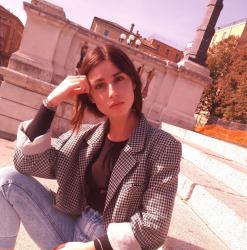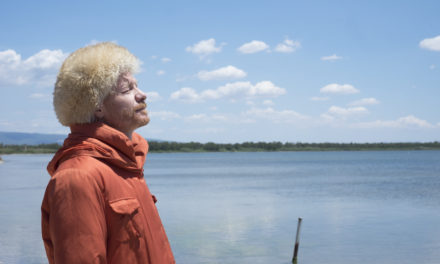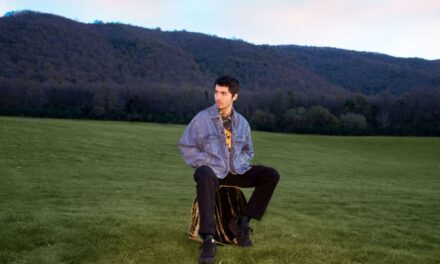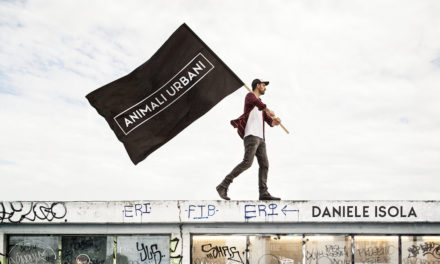Martin Kohlstedt, a German composer, pianist and producer of neo-classical, ambient and electronic music, is one of the most interesting artists on the European scene, returns today, on 9th December, with his new single ‘MOD‘. We interviewed him, here you can read the article to find out what we talked about!
Martin Kohlstedt, compositore, pianista e produttore tedesco di musica neoclassica, ambient ed elettronica, tra i più interessanti del nuovo panorama europeo, ritorna oggi, 9 dicembre, con il suo nuovo singolo “MOD“. Lo abbiamo intervistato, vi lasciamo qui l’articolo per scoprire cosa ci siamo detti!
Hi Martin, welcome to our site! On December the 9th you are going to release your new single “MOD”: an halfway track between neoclassic and electronic music. What was your inspiration to write this song?
My piece MOD is a combative piece. It collides with the current time, so many influences of different kinds that had to be brought into line. Like foaming giant waves that you have to withstand. When I started making this piece I trashed all the sketches I had built conceptually. I only wanted to take seriously the very organic, intuitive outcome where the idea exceeded the 70% mark after a short time without thinking too much, the way I have always done it on stage. It’s like the difference between two-dimensionality and three-dimensionality, the potential of every piece from which you take a step back and “just let it run” is far higher than planned, compositional thinking for me. So the heart of MOD was born in a 90 minute session during a crazy warm summer night.
We can define you an all-round artist. If we take a look at the covers of your single, what they have in common is the fact that they are more similar to a painting. Are they going to create like a jigsaw with the release of your album?
Correct. If you zoom out the single covers, you‘ll get an overall picture. It‘s created by the Leipzig artist Dorothee Liebscher and when choosing the cover for »Feld«, I fell in love with it. Her work is called »Einleuchten« and is actually a 2×2 meter oil painting that not only opens up a whole world of its own – it is the perfect metaphor for what I have created musically.
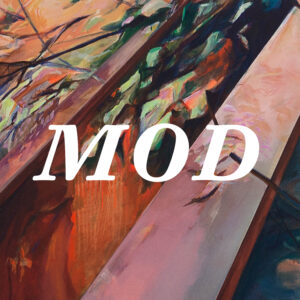
So, what is the connection between figurative art and music, I mean, do they come to life one before the other?
Sometimes the architecture of a painting is like frozen music. Lines and shapes rhythmize what is to be seen in a defined field, the colors express the moment on a spectrum. In art, every form of expression has its limits, otherwise we wouldn’t be so persistent in looking for more ways to proceed. That is why it is so important to unite, or better: collide the arts at one point or another. Only with the friction comes the development!
You have been carrying out “The Forest” project in southern Thuringia, the “green heart” of Germany, for more than 20 years. What was the moment when you had the idea of starting such a bold project?
The idea for this endeavour has been brewing for more than 20 years at this point: Back then I, with the help of my family and many other volunteers, planted a little forest in my small hometown in the very middle of Germany. My father who was the head of the local forestry department at the time set out with his spade as a role model and taught my brother Michael and me everything we needed to know to understand this complex ecosystem. Just as lectures by parents tend to be they were annoying at times but today, in a time where this knowledge is more valuable and important than ever, I am very thankful for receiving them.
Long story short: According to studies there is almost nothing as effective as a forest to combat catastrophic climate change. I was able to put enough money aside that I was able to purchase the first three pieces of land right here in the region. Under my lead and with the help of many volunteer hands we started to plant the first 4500 young trees. In the future not only thousands of trees should grow but also the piece of land it stands on.
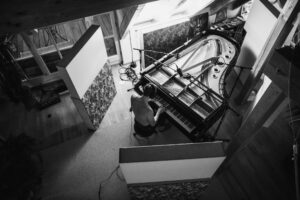
What is the sweetest memory you have of the forest or of your relationship with nature?
I was about 16 years old, I had celebrated the first time alone with my boys my birthday in the forest. For a long time we remained at the campfire until our paths separated at the end of the party, each individually had to go in a different direction. Why ever we all went alone I can no longer say today.
It was a ravendark night and extremely creepy. I started to whistle so that the silence did not make me completely crazy and after all, I still had three kilometers ahead of me. While I was wandering through the dark night, I heard a loud crack that made me freeze like a flash. I was full of adrenaline and tried to find out what it was: ten seconds later a wild boar ran over me full of force. I think this moment really made me a forest child.
Have you ever thought about your music as a journey between you and your listeners?
Since my concerts are always different and completely improvised, the approach to making music can be described as a journey. Initially still repititive and based on simple structures, the music makes its own way into the unknown, so to say.
Usually I play the first 30 seconds as planned and then let the audience, the space, the moment react with each other and influence the further interpretation of the piece. I’d like to see the audience as a mirror or a dialogue partner that brings
up things that are on my mind — and vice versa I have a similiar effect on the people in the audience. This creates a special kind of communication and intimacy that makes me aware of details and affects how I interpret or even recompose the piece. That, of course, can either succeed or go wrong, but either way it creates definitely a special journey.
We know that you have graduated from Media Art & Design at the Bauhaus-University of Weimar, developing projects in Generative Music, Computer Music, Random Music. How important is it for you to incorporate the reality around you into your projects?
During my studies I was fascinated by other perspectives on music and its creation. Of a particular interest for me in this instance was music that composes itself: With this goal in mind I could venture further and further towards the origin of music – intangible and free of logic or other in a way constraining variables like the subconscious, the meditative, intuition, improvisation, or the need for communication. Freedom emerges!
Early in my journey I started to hold on to my approaches and compositional ideas in patches, a ” modular musical vocabulary”, if you will. But of course it always had its limits, and every limit I found in it adversely opened up a lot of potential for development and a step towards discovering the real human beneath all of it.
Together with beautiful crew of people we were invited to create an installation on Burning Man where a prototype of our envisioned “composition machine” was running: It feeds off of the noises and sounds around it, learns its own vocabulary, analyzes and processes it and feeds it into its own composition while also interacting with the people around it.
Before saying goodbye, leave us with a statement that you have learned from nature and that we can apply to our everyday life to improve our stay on this planet!
My fascination with the nature lies in the relativity of time. The trees barely reach my knees and are already 3-4 years old, I will never stand in their shade. If I break the plum, all these years are over. In contrast, it takes a century for the trees to become a young forest. They existed a long time before I did and hopefully will getting so much older than me. The feeling of accompanying only a small period of these beings makes me humble every time. I am only an unimportantly small part of their existence.
Italian translation – Versione italiana
Ciao Martin, benvenuto sul nostro sito! Oggi 9 dicembre pubblichi il tuo nuovo singolo “MOD”: un brano a metà strada tra musica neoclassica ed elettronica. Qual è stata la tua ispirazione per scrivere questa canzone?
Il mio brano MOD è un pezzo battagliero. Si scontra con il tempo attuale, con tante influenze di diverso tipo che dovevano allinearsi. Come onde gigantesche e spumeggianti a cui bisogna resistere. Quando ho iniziato a realizzare questo brano ho cestinato tutti le bozze che avevo messo su concettualmente. Volevo considerare seriamente solo il risultato più organico, intuitivo, in cui l’idea superava il 70% dopo poco tempo trascorso senza pensarci troppo, come ho sempre fatto sul palco. È come la differenza tra bidimensionalità e tridimensionalità, il potenziale di ogni pezzo da cui poi si fa un passo indietro e lo si “lascia correre” è per me molto più importante del pensiero pianificato e compositivo. Così il cuore di MOD nasce in una sessione di 90 minuti durante una calda notte d’estate.
Possiamo definirti un artista a tutto tondo. Se diamo un’occhiata alle copertine dei tuoi singoli, ciò che hanno in comune è il fatto di essere più simili a un dipinto. Si creeranno come un puzzle con l’uscita del suo album?
Esatto. Se si ingrandiscono le copertine dei singoli, si ottiene un quadro generale. È stata creata da un’artista di Lipsia, Dorothee Liebscher, e quando ho scelto la copertina di “Feld” me ne sono innamorato. Il suo lavoro si chiama “Einleuchten” ed è in realtà un dipinto a olio di 2×2 metri che non solo apre un mondo a sé stante, ma è la metafora perfetta di ciò che ho creato musicalmente.
Qual è il legame tra l’arte figurativa e la musica, cioè, prendono vita l’una prima dell’altra?
A volte l’architettura di un dipinto è come musica congelata. Le linee e le forme ritmano ciò che si vede in un campo definito, i colori esprimono il momento in uno spettro. Nell’arte, ogni forma di espressione ha i suoi limiti, altrimenti non saremmo così ostinati a cercare altri modi di andare avanti. Ecco perché è così importante unire, o meglio: far collidere le arti in un punto o nell’altro. Solo attraverso l’attrito c’è lo sviluppo!
Da oltre 20 anni portate avanti il progetto “The Forest” nel sud della Turingia, il “cuore verde” della Germania. Qual è stato il momento in cui hai avuto l’idea di avviare un progetto così audace?
L’idea di questa impresa è nata più di 20 anni fa: all’epoca, con l’aiuto della mia famiglia e di molti altri volontari, ho piantato un piccolo bosco nella mia piccola città natale, nel cuore della Germania. Mio padre, che all’epoca era il capo del dipartimento forestale locale, si mise in cammino con la sua vanga e insegnò a me e a mio fratello Michael tutto ciò che dovevamo sapere per comprendere questo complesso ecosistema. Così come le lezioni impartite dai genitori, a volte potevano essere fastidiose in passato, oggi, in un’epoca in cui queste conoscenze sono più preziose e importanti che mai, sono invece molto gradite.
Per farla breve: secondo gli studi, non c’è nulla di più efficace come una foresta per combattere i cambiamenti climatici catastrofici. Sono riuscito a mettere da parte abbastanza denaro da poter acquistare i primi tre terreni proprio in questa regione. Sotto la mia guida e con l’aiuto di molti volontari abbiamo iniziato a piantare i primi 4500 alberi. In futuro non saranno solo le migliaia di alberi a crescere, ma anche il terreno su cui sorgono.
Qual è il ricordo più bello che hai del bosco o del tuo rapporto con la natura?
Avevo circa 16 anni, avevo festeggiato per la prima volta da solo con i miei amici il mio compleanno nel bosco. Rimanemmo a lungo vicino ai falò finché, alla fine della festa, le nostre strade si separarono, ognuno doveva andare in una direzione diversa. Il motivo per cui ce ne andammo tutti da soli ancora non riesco a capirlo.
Era una notte buia ed estremamente inquietante. Cominciai a fischiettare per evitare che il silenzio mi facesse impazzire del tutto e, dopotutto, avevo ancora tre chilometri davanti a me. Mentre vagavo nella notte buia, ho sentito un forte crack che mi fece gelare il sangue. Ero pieno di adrenalina e carcai di capire cosa fosse: dieci secondi dopo un cinghiale mi era venuto addosso con violenza. Credo che questo momento mi abbia reso davvero un bambino della foresta.
Hai mai pensato alla tua musica come a un viaggio tra quest’ultima e i tuoi ascoltatori?
Poiché i miei concerti sono sempre diversi e completamente improvvisati, l’approccio alla musica può essere descritto come un viaggio. All’inizio è più ripetitiva e basata su strutture semplici, è come se la musica si facesse strada verso l’ignoto, per così dire.
Di solito suono i primi 30 secondi come avevo previsto e poi lascio che il pubblico, lo spazio, il momento reagiscano l’uno con l’altro e influenzino l’ulteriore interpretazione del pezzo. Mi piace vedere il pubblico come uno specchio o un interlocutore che fa emergere le cose che mi passano per la testa e viceversa. Io ho un effetto simile sulle persone in platea. Questo crea un tipo di comunicazione speciale e un’intimità che mi rende consapevole dei dettagli e influisce sul modo in cui interpreto o addirittura ricompongo il pezzo. Questo, naturalmente, può avere successo così come andare male, ma in ogni caso crea un viaggio speciale.
Sappiamo che ti sei laureato in Media Art & Design alla Bauhaus-University di Weimar, sviluppando progetti di Musica Generativa, Computer Music, Musica Casuale. Quanto è importante per te incorporare la realtà circostante nei tuoi progetti?
Durante i miei studi sono stato affascinato da altre prospettive sulla musica e sulla sua creazione. In particolare, mi interessava la musica che si compone da sola: Con questo obiettivo in mente potevo avventurarmi sempre di più verso l’origine della musica – intangibile e libera dalla logica o da altre variabili in qualche modo vincolanti come il subconscio, la meditazione, l’intuizione, l’improvvisazione o il bisogno di comunicazione. Emerge la libertà!
All’inizio del mio percorso ho iniziato a conservare i miei approcci e le mie idee compositive in un patch, un “vocabolario musicale modulare”, se vogliamo. Ma naturalmente ha sempre avuto i suoi limiti, e ogni limite mi ha aperto a un sacco di potenziale per sviluppare, un passo verso la scoperta del vero umano sotto tutto questo.
Insieme a un bel gruppo di persone siamo stati invitati a creare un’installazione al Burning Man in cui era in funzione un prototipo della nostra immaginata “macchina per comporre”, che si nutre dei rumori e dei suoni che la circondano, impara il proprio vocabolario, lo analizza, lo elabora e lo inserisce nella propria composizione, interagendo al contempo con le persone che la circondano.
Prima di salutarci, lasciaci una frase che hai imparato dalla natura e che possiamo applicare alla vita quotidiana per migliorare la nostra permanenza su questo pianeta!
Il mio fascino per la natura riguarda la relatività del tempo. Gli alberi mi arrivano a malapena alle ginocchia e hanno già 3-4 anni, non potrò mai stare a godere della loro ombra. Al contrario, gli alberi impiegano un secolo per diventare una giovane foresta. Esistono da molto tempo prima di me e si spera che diventino molto più vecchi di me. La sensazione di accompagnare solo un piccolo periodo di questi esseri mi riempie ogni volta di umiltà. Sono solo una piccola parte, non importante, della loro esistenza.

![Tra la foresta e la musica di Martin Kohlstedt [intervista IT e ENG version]](https://www.beatandstyle.com/wp-content/uploads/2022/12/©J-Konrad-Schmidt_1-e1670931660444-1280x640.jpg)
